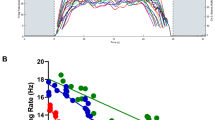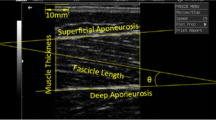Abstract
Improving muscle strength and preventing muscle weakness are important for older adults. The change in strength can be effectively explained by skeletal muscle mass and neural factors. Neural factors are important for older adults because the variation of neural components is greater in older than in young adults, and any decline in strength cannot solely be explained by a decrease in skeletal muscle mass. The purpose of the present study was to investigate whether skeletal muscle mass or motor unit firing properties could explain the change in muscle strength after 1 year. Thirty-eight older adults (75.0 ± 4.7 years, 156.6 ± 7.7 cm, 55.5 ± 9.4 kg, 26 women) performed maximum voluntary knee extension and their skeletal muscle mass was measured using a bioimpedance device. During a submaximal contraction task, high-density surface electromyography was recorded and the signals were decomposed into individual motor unit firing. As an index of motor unit firing properties, the slope and y-intercept (MU intercept) were calculated from the regression line between recruitment thresholds and firing rates in each participant. After 1 year, their maximum knee extension torque was evaluated again. A stepwise multiple regression linear model with sex and age as covariates indicated that MU intercept was a significant explanation with a negative association for the 1-year change in muscle strength (β = − 0.493, p = 0.004), but not skeletal muscle mass (p = 0.364). The results suggest that neural components might be predictors of increasing and decreasing muscle strength rather than skeletal muscle mass.




Similar content being viewed by others
Data Availability
Data will be provided by the corresponding author upon request.
References
Vanden Noven ML, et al. Motor variability during sustained contractions increases with cognitive demand in older adults. Front Aging Neurosci. 2014;6:97.
Degens H, Korhonen MT. Factors contributing to the variability in muscle ageing. Maturitas. 2012;73(3):197–201.
Hunter SK, Pereira HM, Keenan KG. The aging neuromuscular system and motor performance. J Appl Physiol. 2016;121(4):982–95.
Piasecki M, et al. Age-related neuromuscular changes affecting human vastus lateralis. J Physiol. 2016;594(16):4525–36.
Yoshiko A, et al. Applicability of the seated step test for assessing thigh muscle sarcopenia in older individuals. Exp Gerontol, 2023;112283.
Chen LK, et al. Sarcopenia in Asia: consensus report of the Asian Working Group for Sarcopenia. J Am Med Dir Assoc. 2014;15(2):95–101.
Cruz-Jentoft AJ, et al. Sarcopenia: European consensus on definition and diagnosis: report of the European Working Group on Sarcopenia in Older People. Age Ageing. 2010;39(4):412–23.
Wilkinson DJ, Piasecki M, Atherton PJ. The age-related loss of skeletal muscle mass and function: measurement and physiology of muscle fibre atrophy and muscle fibre loss in humans. Ageing Res Rev. 2018;47:123–32.
Piasecki M, et al. Age-dependent motor unit remodelling in human limb muscles. Biogerontology. 2016;17(3):485–96.
Manini TM, Hong SL, Clark BC. Aging and muscle: a neuron’s perspective. Curr Opin Clin Nutr Metab Care. 2013;16(1):21–6.
Hirono T, et al. Motor unit firing patterns in older adults with low skeletal muscle mass. Arch Gerontol Geriatr. 2023;116:105151.
Duchateau J, Hainaut K. Effects of immobilization on contractile properties, recruitment and firing rates of human motor units. J Physiol. 1990;422:55–65.
Inns TB, et al. Motor unit dysregulation following 15 days of unilateral lower limb immobilisation. J Physiol. 2022;600(21):4753–69.
Sirago G, et al. Loss of neuromuscular junction integrity and muscle atrophy in skeletal muscle disuse. Ageing Res Rev. 2023;83:101810.
Piasecki M, et al. Failure to expand the motor unit size to compensate for declining motor unit numbers distinguishes sarcopenic from non-sarcopenic older men. J Physiol. 2018;596(9):1627–37.
Hirono T, et al. Effects of home-based bodyweight squat training on neuromuscular properties in community dwelling older adults. Aging Clin Exp Res. 2023;35(5):1043–53.
Kamen G, Knight CA. Training-related adaptations in motor unit discharge rate in young and older adults. J Gerontol A Biol Sci Med Sci. 2004;59(12):1334–8.
Moritani T, deVries HA. Potential for gross muscle hypertrophy in older men. J Gerontol. 1980;35(5):672–82.
Pearcey GEP, et al. Chronic resistance training: is it time to rethink the time course of neural contributions to strength gain? Eur J Appl Physiol. 2021;121(9):2413–22.
Duchateau J, Enoka RM. Human motor unit recordings: origins and insight into the integrated motor system. Brain Res. 2011;1409:42–61.
Holobar A, Zazula D. On the selection of the cost function for gradient-based decomposition of surface electromyograms. Annu Int Conf IEEE Eng Med Biol Soc. 2008;2008:4668–71.
Holobar A, Zazula D. Correlation-based decomposition of surface electromyograms at low contraction forces. Med Biol Eng Comput. 2004;42(4):487–95.
Feeney DF, Mani D, Enoka RM. Variability in common synaptic input to motor neurons modulates both force steadiness and pegboard time in young and older adults. J Physiol. 2018;596(16):3793–806.
Peduzzi P, et al. Importance of events per independent variable in proportional hazards regression analysis. II. Accuracy and precision of regression estimates. J Clin Epidemiol. 1995;48(12):1503–10.
Holobar A, et al. Estimating motor unit discharge patterns from high-density surface electromyogram. Clin Neurophysiol. 2009;120(3):551–62.
Farina D, et al. Decoding the neural drive to muscles from the surface electromyogram. Clin Neurophysiol. 2010;121(10):1616–23.
Adam A, De Luca CJ. Firing rates of motor units in human vastus lateralis muscle during fatiguing isometric contractions. J Appl Physiol. 2005;99(1):268–80.
Fuglevand AJ, Winter DA, Patla AE. Models of recruitment and rate coding organization in motor-unit pools. J Neurophysiol. 1993;70(6):2470–88.
Hirono T, et al. Acute changes in motor unit discharge property after concentric versus eccentric contraction exercise in knee extensor. J Electromyogr Kinesiol. 2022;67:102704.
Okudaira M, et al. Longitudinal development of muscle strength and relationship with motor unit activity and muscle morphological characteristics in youth athletes. Exp Brain Res. 2023;241(4):1009–19.
Watanabe K, et al. Neuromuscular characteristics of front and back legs in junior fencers. Exp Brain Res. 2022;240(7–8):2085–96.
Clark LA, et al. Reduced neural excitability and activation contribute to clinically meaningful weakness in older adults. J Gerontol A Biol Sci Med Sci. 2021;76(4):692–702.
Clark BC, Manini TM. What is dynapenia? Nutrition. 2012;28(5):495–503.
Manini TM, Clark BC. Dynapenia and aging: an update. J Gerontol A Biol Sci Med Sci. 2012;67(1):28–40.
Fukumoto Y, et al. Skeletal muscle quality assessed from echo intensity is associated with muscle strength of middle-aged and elderly persons. Eur J Appl Physiol. 2012;112(4):1519–25.
Taniguchi M, et al. Increase in echo intensity and extracellular-to-intracellular water ratio is independently associated with muscle weakness in elderly women. Eur J Appl Physiol. 2017;117(10):2001–7.
Hughes VA, et al. Longitudinal muscle strength changes in older adults: influence of muscle mass, physical activity, and health. J Gerontol A Biol Sci Med Sci. 2001;56(5):B209–17.
Metter EJ, et al. Muscle quality and age: cross-sectional and longitudinal comparisons. J Gerontol A Biol Sci Med Sci. 1999;54(5):B207–18.
Martinez-Valdes E, et al. Tracking motor units longitudinally across experimental sessions with high-density surface electromyography. J Physiol. 2017;595(5):1479–96.
Del Vecchio A, et al. The increase in muscle force after 4 weeks of strength training is mediated by adaptations in motor unit recruitment and rate coding. J Physiol. 2019;597(7):1873–87.
Pucci AR, Griffin L, Cafarelli E. Maximal motor unit firing rates during isometric resistance training in men. Exp Physiol. 2006;91(1):171–8.
Rutherford OM, Jones DA. The role of learning and coordination in strength training. Eur J Appl Physiol Occup Physiol. 1986;55(1):100–5.
Semmler JG, Nordstrom MA. Motor unit discharge and force tremor in skill- and strength-trained individuals. Exp Brain Res. 1998;119(1):27–38.
Herda TJ. Resistance exercise training and the motor unit. Eur J Appl Physiol. 2022;122(9):2019–35.
Fukumoto Y, et al. Association of physical activity with age-related changes in muscle echo intensity in older adults: a 4-year longitudinal study. J Appl Physiol. 2018;125(5):1468–74.
Daly RM, et al. Association between changes in habitual physical activity and changes in bone density, muscle strength, and functional performance in elderly men and women. J Am Geriatr Soc. 2008;56(12):2252–60.
Greig CA, Botella J, Young A. The quadriceps strength of healthy elderly people remeasured after eight years. Muscle Nerve. 1993;16(1):6–10.
Van Vossel K, et al. Can muscle typology explain the inter-individual variability in resistance training adaptations? J Physiol. 2023;601(12):2307–27.
Piotrkiewicz M, et al. Age-related change in duration of afterhyperpolarization of human motoneurones. J Physiol. 2007;585(Pt 2):483–90.
Dalton BH, et al. Differential age-related changes in motor unit properties between elbow flexors and extensors. Acta Physiol (Oxf). 2010;200(1):45–55.
Acknowledgements
We would like to thank Dr. Shun Kunugi, Dr. Masamichi Okudaira, Ms. Saeko Ueda, Dr. Akito Yoshiko, Ms. Yoko Kawakami, and lab. members for helping with data collection. We also appreciate Prof. Aleš Holobar of the University of Maribor, Slovenia, for supporting the analyses of motor unit firing properties using the DEMUSE tool.
Funding
This study was financially supported by a Grant-in-Aid from the Japan Society for the Promotion of Science Fellows (21J00674 and 22KJ2973).
Author information
Authors and Affiliations
Corresponding author
Ethics declarations
Competing interests
The authors declare no competing interests.
Additional information
Publisher's Note
Springer Nature remains neutral with regard to jurisdictional claims in published maps and institutional affiliations.
About this article
Cite this article
Hirono, T., Takeda, R., Nishikawa, T. et al. Prediction of 1-year change in knee extension strength by neuromuscular properties in older adults. GeroScience 46, 2561–2569 (2024). https://doi.org/10.1007/s11357-023-01035-6
Received:
Accepted:
Published:
Issue Date:
DOI: https://doi.org/10.1007/s11357-023-01035-6




